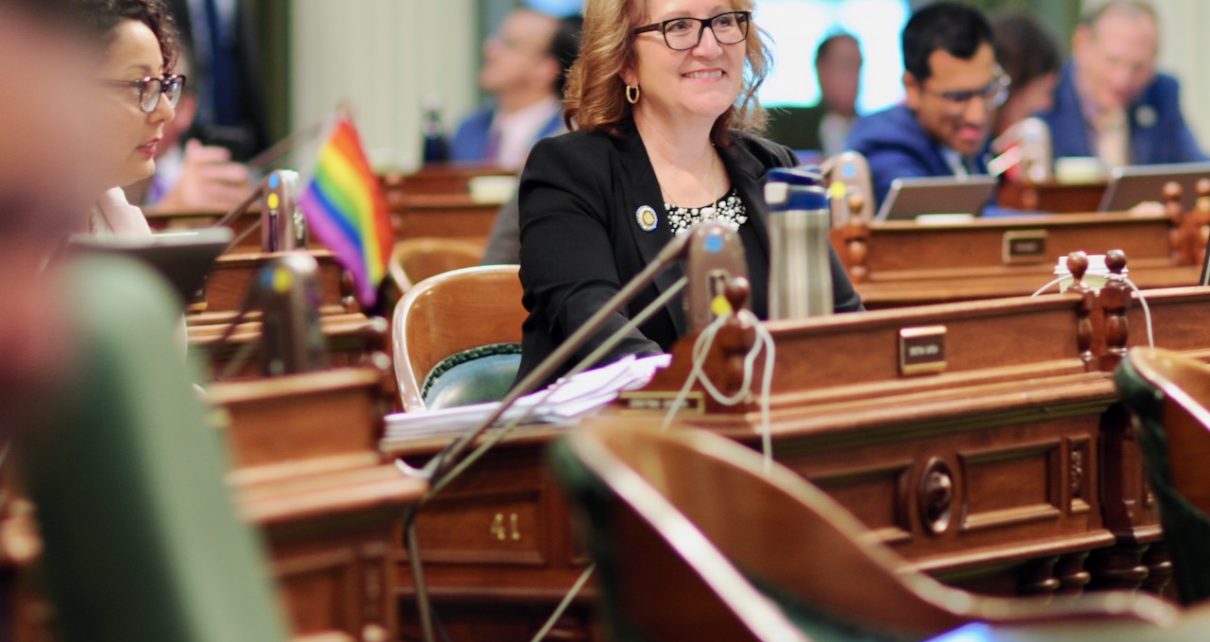
Eloise Gómez Reyes. (Photo: Kevin Sanders for California Globe)
AB 35 Deal to Modify Medical Injury Compensation Reform Act of 1975
California’s medical malpractice payouts would increase under the deal
By Chris Micheli, April 28, 2022 10:27 am
On April 27, Assembly Bill 35 (which had dealt with false information and was authored by former Assemblyman Ed Chau) was gutted and amended to revise the Medical Injury Compensation Reform Act of 1975 (MICRA) statute. AB 35 is now jointly authored by Assembly Member Eloise Gomez Reyes and Senator Tom Umberg, and is co-authored by 38 legislators.
AB 35 would amend Section 6146 of the Business and Professions Code, amend Section 3333.2 of the Civil Code, amend Section 667.7 of the Code of Civil Procedure, and add Chapter 3 (commencing with Section 104340) to Part 2 of Division 103 of the Health and Safety Code. MICRA has been in existence for over 45 years and, among other provisions, limits the amount of damages for noneconomic losses in an action for injury against a health care provider based on professional negligence to $250,000.

Among other changes being made by AB 35, the bill would remove the $250,000 limit on noneconomic damages and expand the law to include an action for injury against a health care institution, and it would increase annually the amount of the limitation and eventually adjust it annually for inflation. And, AB 35 would allow statements related to sympathy or regret not be admitted into evidence.
Section One of the bill provides a statement of legislative findings and declarations that the purpose and intent of the Medical Injury Compensation Reform Act (MICRA) will be served by updating key provisions. Nothing contained herein shall be interpreted in a manner to alter or nullify existing case law interpreting MICRA and its statutory provisions. In addition, “establishing an environment in the health care delivery setting that encourages transparency and open communication will protect California patients and improve health care provider well-being.”
Section Two of the bill would amend Business and Professions Code Section 6146 to change the amounts of contingency fee limitations charged by an attorney in connection with an action for injury or damage against a health care provider based upon such person’s alleged professional negligence. The new limits would be:
- 25% of the dollar amount recovered if the recovery is pursuant to settlement agreement and release of all claims executed by all parties thereto prior to a civil complaint or demand for arbitration being filed.
- 33% percent of the dollar amount recovered if the recovery is pursuant to settlement, arbitration, or judgment after a civil complaint or demand for arbitration is filed.
In addition, when a case is tried in a civil court or arbitrated, the attorney representing the plaintiff or claimant may file a motion with the court or arbitrator for a contingency fee in excess of the above percentages and decided in the court’s discretion based on evidence establishing good cause for the higher contingency fee.
Section Three of the bill would amend Civil Code Section 3333.2 to add “health care institution” to the current law allowing a civil action against a health care provider. It would delete the $250,000 limitation on damages for noneconomic losses. Instead, the law would now provide that, in any action for injury that does not involve wrongful death against one or more health care providers or health care institutions based on professional negligence, the following limitations would apply:
- Civil liability for damages for noneconomic losses against one or more health care providers, collectively, shall not exceed $350,000.
- Civil liability for damages for noneconomic losses against one or more health care institutions, collectively, shall not exceed $350,000.
In addition, in any action for wrongful death against one or more health care providers or health care institutions based on professional negligence, the following limitations would apply:
- Civil liability for damages for noneconomic losses against one or more health care providers, collectively, shall not exceed $500,000.
- Civil liability for damages for noneconomic losses against one or more health care institutions, collectively, shall not $500,000.
Moreover, no health care provider defendant or health care institution defendant would be liable for damages for noneconomic losses in more than one of the categories set forth in this section, regardless of the application or combined application thereof. The above dollar amounts apply regardless of the number of defendant health care providers or health care institutions against whom the claim is asserted or the number of separate causes of actions on which the claim is based.
In terms of effective date, this new section of AB 35 would apply to all cases filed or arbitrations demanded on or after January 1, 2023. Thereafter, the dollar amounts set forth above would increase by $40,000 each January 1 for 10 years until reaching a limit of $750,000 in civil actions based upon professional negligence. For civil actions based on wrongful death, the dollar amounts set forth above would increase by $50,000 for 10 years until reaching a limit of $1 million.
Thereafter, the applicable amounts set forth above for noneconomic damages for personal injury of $750,000, and for wrongful death of $1,000,000, would be adjusted for inflation on January 1 of each year by 2 percent beginning on January 1, 2034.
AB 35 would also amend the definition of “health care provider” with additional references to the Health and Safety Code and the bill would add a definition for “health care institution” to those health care facilities licensed under the Health and Safety Code, and a definition for “unaffiliated” to mean a specified health care provider, health care institution, or other entity not covered by the definition of “affiliated” under the Corporations Code.
Section Four of the bill would amend Code of Civil Procedure Section 667.7 to increase from $50,000 to $250,00 the maximum amount of a lump-sum payment for future damages to be paid in whole or in part by periodic payments rather than by a lump-sum payment.
Section Five of the bill would add Chapter 3 (commencing with Section 104340) to Part 2 of Division 103 of the Health and Safety Code. Chapter 3 would be titled “Expressions of Sympathy, Benevolence, or Fault in Health Care.” Section 104340 would provide that statements, writings, or benevolent gestures expressing sympathy, regret, a general sense of benevolence, or suggesting, reflecting, or accepting fault relating to the pain, suffering, or death of a person, and made to that person or the family or representative of that person prior to the filing of a lawsuit or demand for arbitration, would be confidential, privileged, protected, not subject to subpoena, discovery, or disclosure,
In addition, AB 35 would add definitions of “adverse patient safety event or unexpected health care outcome”; “benevolent gestures”; and, “family.”
Section Six of the bill contains a severability clause so that, if any provision of this act, or any part of this act, or the application of any provision or part to any person or circumstances, is for any reason held to be invalid, the remaining provisions and parts, and application of the remaining provisions and parts, shall not be affected, but shall remain in full force and effect.
- Pilotage Rates in California - December 16, 2025
- Partition of Property in California - December 15, 2025
- Relief from Child Support Orders - December 14, 2025





Rainbow flags prominently displayed in a public legislative body, eh??
NO favoritism there, is there???
So much for political neutrality and “fairness” for all , right California legislators???
We are governed by triggered, immature emotional CHILDREN….
LGTBBQ is a mental disorder
Doctors in California are having a hard time staying in business. Overhead escalation has already exceeded income increase. With this law you will undoubtedly see doctors leaving practice and or moving out of state. Patient access will decrease even more. I, as a psychiatrist already cannot meet patient demand and increasing overhead that for me already exceeds insurance and Medicare reimbursement . This will make the medical crisis all the much worse. Although I understand some of the logic, in the future all medical care in California will suffer. I encourage Governor Nelson to consider this.